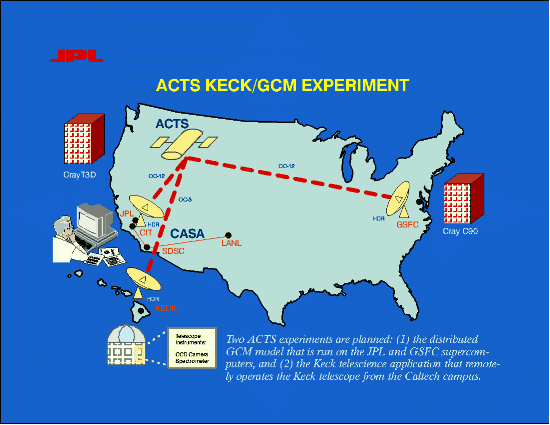
Approach: The two ACTS experiments, Keck and GCM, will be led by JPL and GSFC, respectively, with support from Caltech, UCLA, GWU, and Hawaii PacSpace. The GCM experiment will require a virtual channel connection between the JPL Cray T3D and the GSFC Cray C90, while the Keck experiment will require a virtual channel connection between a remote control room at the Caltech campus in Pasadena, CA, and the Keck Observatory local area network on Mauna Kea, Hawaii. Based on the availability of Asynchronous Transfer Mode (ATM) Synchronous Optical NETwork (SONET) OC-3 network switch and host equipment by early CY95, ATM was selected as the base transport mechanism. This greatly simplifies the terrestrial network infrastructure, especially in the Hawaiian islands and ATDnet. For Keck, Caltech will modify the graphical user interface (GUI) design for use over longer delay channels and multiuser/location control, JPL will perform the network system engineering and atmospheric/fading BER analysis, and GWU the HDR site design and performance modeling. Additionally, PacSpace will assist with scheduling the use of the Honolulu HDR and engineering the Honolulu/Mauna Kea network infrastructure. For GCM, GSFC will lead the porting of the distributed global climate model to the JPL and GSFC Cray supercomputers. GSFC staff scientists will port the Poseidon OGCM and Aries AGCM codes for coupling with UCLA AGCM and GFDL OGCM codes. In both experiments, the effect of fading, burst noise, and long transit delays will be examined and compared against lower error rate terrestrial links.
Accomplishments: During the past year (Oct 94 - Sep 95), the site preparation at JPL and GSFC for the High Data Rate (HDR) terminal was completed (HDRs are expected in early Oct 95). Also, the ``last mile'' ATM SONET OC-3 fiber optic link from Honolulu to the summit of Mauna Kea, Hawaii, was completed--albeit with one small DS3 microwave link segment near the summit. This will restrict data rates to 45 Mbit/s until a final run of fiber can be installed near the summit. It is expected that this final segment will be upgraded in mid 1996. ATM cell lost tests performed in Aug 95 met all requirements for efficient data transfers over ACTS.
Significance: These experiments will demonstrate the feasibility of using long path delay satellite links to establish meta-computing and control/data acquisition networks for remote collaboration, observation, control of science experiments in hostile environments. Example: Antarctic and undersea exploration, petroleum exploration, interconnecting data centers to share large data bases.
Status/Plans: Both applications will be tested over the ACTS during the next year. Full HDR deployment and network connectivity is expected by Oct 95, at which time high bandwidth trials are expected to commence, lasting for 9 additional months (to Jun 96). An additional 6 months of science use is planned from Jun-Dec 96.
Point of Contact:
Larry A. Bergman
Jet Propulsion Laboratory
bergman@kronos.jpl.nasa.gov
(818) 354-4689